Pesticide Usage in Scotland: Outdoor Vegetable Crops 2015
Information from a survey of pesticide use on vegetable crops grown for human consumption in Scotland during 2015.
General trends
Crop area
The estimated area of outdoor vegetable crops grown in 2015 was 16,672 hectares ( Table 35). This represents a four per cent increase from 2013 (3) and a nine per cent increase from 2011 (4). Since the last survey, areas of cabbages, broad beans, calabrese and vining peas increased (47, 27, 19 and seven per cent respectively); while turnips and swedes and Brussels sprouts decreased (21 and six per cent respectively) The carrot crop area remained unchanged ( Figure 1).
In 2015, peas and beans accounted for 51 per cent of the outdoor vegetable crop area, leaf brassicas 18 per cent, carrots 18 per cent, turnips and swedes nine per cent and other vegetable crops four per cent ( Figure 2).
Figure 1 Area of vegetable crops grown in Scotland 2011-2015
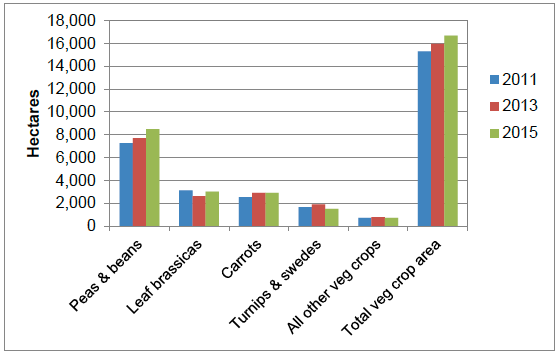
Note: 2011 and 2013 vegetable crop areas include multi-cropping
Figure 2 Vegetable crop areas 2015 (percentage of total area)
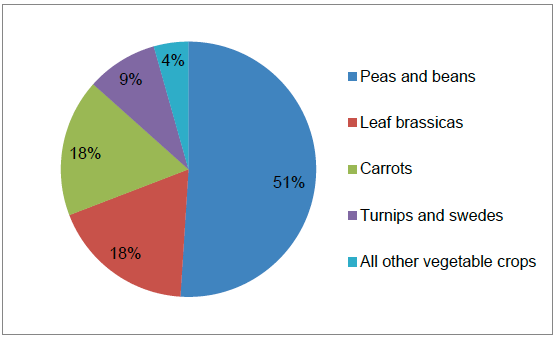
Pesticide usage
The majority of vegetable crops (98 per cent) received a pesticide treatment in 2015. Vining peas, calabrese, turnips and swedes, Brussels sprouts, and broad beans were found to have the highest overall proportion of crop treated with pesticide ( Figures 9 & 10, Table 1). Carrots, other vegetable crops and other brassicas (see appendix 3 – definitions and notes for crop list) were found to have the lowest proportion treated (93, 94 and 95 per cent respectively). In terms of the average number of applications of pesticides, the treated area of vegetable crops received on average 5.8 sprays (excluding seed treatments). It should be noted this only applies to the treated proportion of the crop (98 per cent). Brussel sprouts received the highest number of applications with an average of 14 sprays. In contrast, vining peas only received two sprays on average ( Table 1).
It is estimated that the area of outdoor vegetable crops treated with a pesticide formulation in 2015 was ca. 178,900 hectares compared with ca. 149,600 hectares in 2013 and ca. 138,500 hectares in 2011 ( Table 35). This represents an increase of 20 per cent since 2013 and 29 per cent since 2011. In terms of weight of pesticide applied, 67 tonnes was applied in 2015, representing an increase of 27 per cent from 2013 and an increase of 28 per cent from 2011 ( Table 35).
In order to make accurate comparisons between the 2015 data and the data collected in previous surveys, it is important to take into account differences in crop areas between the years. Therefore, the number of treated hectares per hectare of crop grown and the total weight of pesticide used per hectare of crop grown were calculated. Once crop area has been taken into account, there has been an increase in the area and weight of pesticides applied ( Figures 5 & 8). In 2015, for each hectare of crop grown, around 11 pesticide treated hectares were recorded ( Figure 5). This represents an increase of 15 per cent from 2013 and 19 per cent from 2011. The estimated quantity of pesticides applied per hectare of crop grown was four kilograms ( Figure 8). This represents an increase of 22 per cent from 2013 and an increase of 18 per cent from 2011.
Fungicides were the most frequently used pesticides on outdoor vegetable crops, followed by herbicides and insecticides ( Figure 3). This pattern was also observed in 2013 and 2011 ( Figure 4). In 2015, fungicides accounted for 33 per cent of the total pesticide treated area and 30 per cent of the total weight of active substances applied ( Figures 3 & 6). When changes in crop area are taken into account, the area treated by fungicides increased by 32 per cent from 2013 to 2015 and 18 per cent between 2011 and 2015 ( Figure 5). From 2013 to 2015, there was an increase of 42 per cent in the quantity of fungicides used per hectare of crop grown ( Figure 8). From 2011 to 2015, there was a decrease of one per cent in the quantity of fungicides used per hectare of crop grown. The increased use of fungicides in 2015 was not the result of high disease pressure, which was suppressed by the cool spring. As reported in the previous survey, 2013 was a notable low disease year (3).
Sulphur accounted for one per cent of the total pesticide treated area and nine per cent of the total weight of active substances applied ( Figures 3 & 6). When changes in area grown are taken into account, there was a 64 per cent increase in the use of sulphur between 2013 and 2015 and a 43 per cent increase between 2011 and 2015 ( Figure 5). The quantity of sulphur applied per hectare of crop grown increased by 14 per cent from 2013 to 2015 and increased by 55 per cent from 2011 to 2015 ( Figure 8). The majority of sulphur use was on calabrese and vining peas, which have seen increases in crop area ( Table 1). Where reasons were specified, sulphur was used for the control of disease.
In 2015, herbicides accounted for 28 per cent of the total pesticide treated area and 50 per cent of the total weight of active substances applied ( Figures 3 & 6), the same pattern as observed in 2013. When changes in crop area are taken into account, there is an increase in area treated with herbicide formulations of 16 per cent from 2013 to 2015 and 24 per cent from 2011 to 2015 ( Figure 5). In terms of weight of active substance applied, when area of crop grown is taken into account, there was an increase of 22 per cent from 2013 to 2015 and an increase of 28 per cent from 2011 to 2015 ( Figure 8). In 2015, the cool dry spring lead to delayed emergence of weeds and also to poor activity of some herbicides, which may have resulted in additional sprays (Fiona Burnett, SRUC pers.comm.).
Insecticides accounted for 25 per cent of the total pesticide treated area and six per cent of the total weight of active substances applied ( Figures 3 & 6). The levels of insecticides used in 2015 were very similar to those used in 2013. When changes in area of crop grown are taken into account, there was a three per cent increase from 2013 to 2015 and a 25 per cent increase from 2011 to 2015 in the area treated with insecticide formulations ( Figure 5). This pattern is repeated in terms of quantity applied per hectare of crop grown, with a two per cent increase from 2013 to 2015 and a 49 per cent increase from 2011 ( Figure 8).
Over 75 per cent of leaf brassica crops and 19 per cent of other vegetable crops were grown from transplants. The remaining crops were all grown directly from seed. Of these, vining peas, broad beans and turnips and swedes had the highest proportion of treated seed with all of the seed reported as treated ( Table 1). Seed treatments accounted for nine per cent of the total area treated and two per cent of the total weight of active substances applied ( Figures 3 & 6). When changes in crop area are taken into account, there was an increase in area treated by seed treatments of seven per cent from 2013 to 2015 and an increase of 22 per cent from 2011 to 2015 ( Figure 5). The quantity of seed treatment applied per hectare of crop grown remained at similar levels, with a four per cent increase from 2013 to 2015 and a five per cent increase from the from 2011 to 2015 ( Figure 8).
Molluscicides accounted for four per cent of the total pesticide treated area and two per cent of the total weight of active substances ( Figures 3 & 6). When changes in crop areas between years are taken into account, there is a decrease in molluscicide applications per unit area of 17 per cent between 2013 and 2015 and a decrease of 30 per cent between 2011 and 2015 ( Figure 5). The quantity of molluscicides applied per hectare of crop grown decreased by 21 per cent from 2013 to 2015 and by 54 per cent from 2011 to 2015 ( Figure 8). This pattern may be partly explained by the current industry-led stewardship scheme which aims to promote and encourage best practice with metaldehyde slug pellets to minimise environmental impacts. Also, the late and cold spring may have reduced the levels of slug activity (5).
Growth regulators accounted for less than one per cent of the total pesticide treated area and one per cent of the total weight of active substances applied ( Figures 3 & 6). Growth regulators were only recorded on parsnips within the other vegetable crops category ( Table 14). No growth regulators were recorded on outdoor vegetable crops in 2013 or in 2011.
Biopesticides were encountered on Brussels sprouts, cabbages and in the other vegetable crop category. Biopesticides accounted for less than one per cent of the total pesticide treated area and less than one per cent of the total weight of active substances applied ( Figures 3 & 6). No biopesticides were recorded in the 2013 survey. When changes in crop area are taken into account, there was a 198 per cent increase in area treated and a 130 per cent increase in weight of active substance applied from 2011 to 2015 ( Figures 5 & 8).
As well as overall trends with pesticide groups since 2013, there has been variation in the use of individual active substances. For example, the use of the fungicide cyprodinil, increased by 120 per cent in terms of area treated and 112 per cent in terms of quantity of active substance applied ( Tables 33 & 34). The fungicide active substance fenhexamid was recorded in this survey series for the first time. The area treated by the herbicide glyphosate increased by 110 per cent by area treated and 76 per cent by quantity of active substance applied. The herbicide prosulfocarb increased by 100 per cent in terms of quantity of active substance applied and 99 per cent in terms of area treated. The fungicide copper oxychloride increased by 91 per cent in terms of area treated and 102 per cent in terms of quantity of active substance applied. Some of the patterns seen in use of active substances can be attributed to changes in crop area. For example, glyphosate was recorded on peas, broad beans and calabrese, all of which showed increases in crop area grown.
For the first time in this series of reports, fungicides and herbicides have been classified into groups according to their mode of action ( Tables 30- 32). It is hoped this information will provide useful trend data in future reports.
Figure 3 Use of pesticides on outdoor vegetable crops (percentage of total area treated with formulations) – 2015
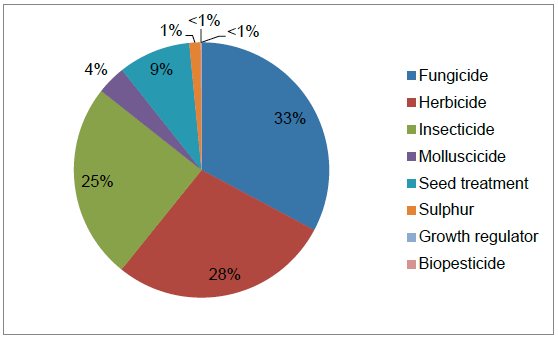
Figure 4 Area of vegetable crops treated with the major pesticide groups in Scotland 2011-2015
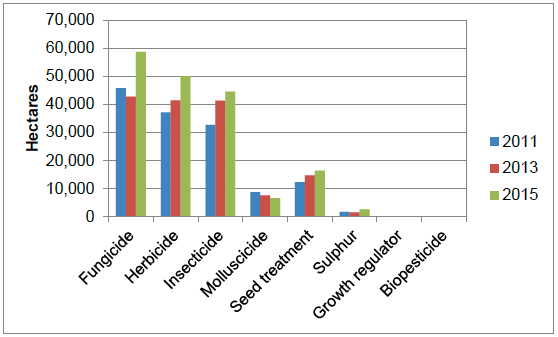
Figure 5 Number of pesticide treated hectares (formulations) per each hectare of crop grown
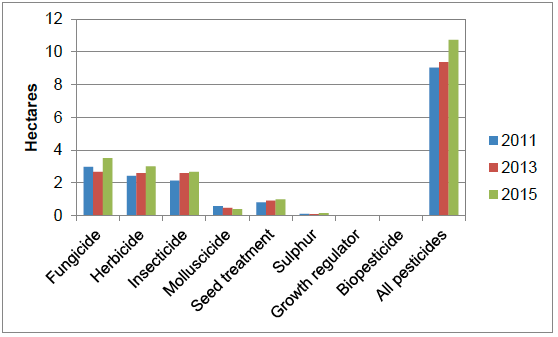
Figure 6 Use of pesticides on outdoor vegetable crops (percentage of total quantity of active substances applied) – 2015
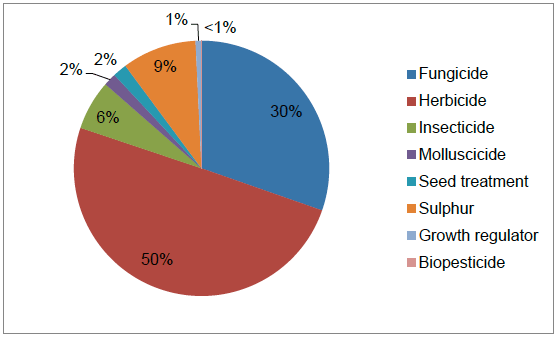
Figure 7 Quantity of the major pesticide groups applied to vegetable crops in Scotland 2011-2015
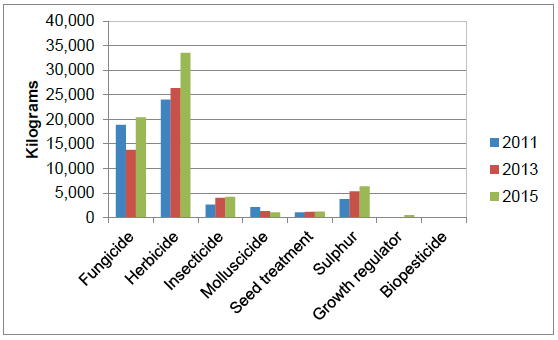
Figure 8 Weight of pesticides applied per each hectare of crop grown
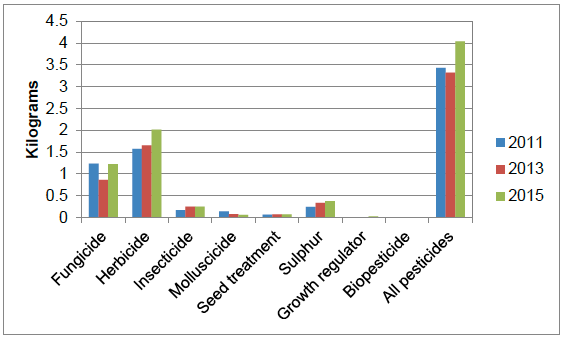
Figure 9 Percentage of leaf brassica crops treated with pesticides 2015
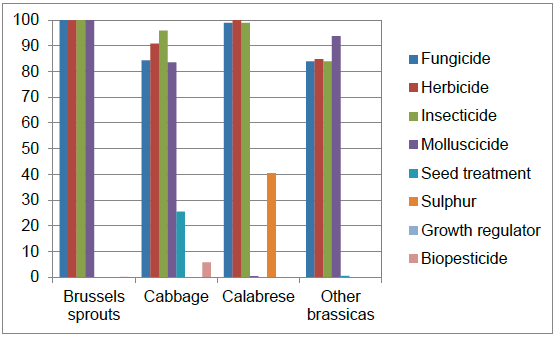
Note: Other brassicas include sprouting broccoli, cauliflower and kale.
Figure 10 Percentage of legumes and vegetable crops treated with pesticides 2015
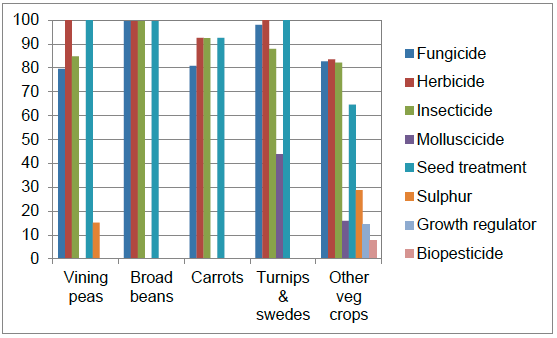
Note: Other vegetable crops include beetroot, curly parsley, garlic, leeks, leeks, lettuce, onions, parsnips, podded peas, radish, rhubarb, rocket and runner beans.
Figure 11 Average number of pesticide applications on treated area of leaf brassica crops - 2015
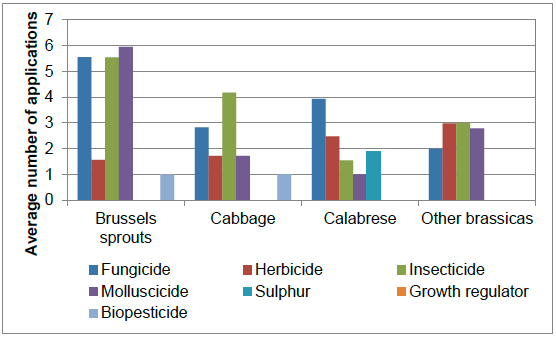
Note: Other brassicas include sprouting broccoli, cauliflower and kale.
Average number of applications calculated for area treated with that pesticide group only. See Appendix 3 - definitions and notes for details and Table 1 for percentage of crop treated.
Figure 12 Average number of pesticide applications on treated area of legumes and vegetable crops – 2015
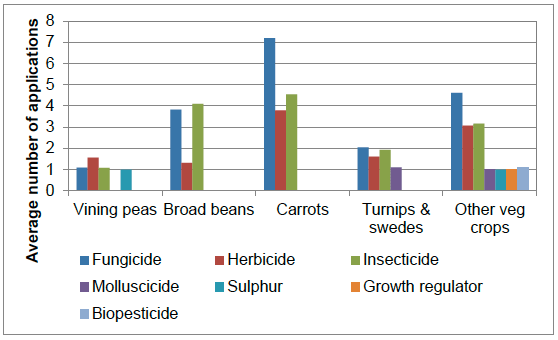
Note: Other vegetable crops include beetroot, curly parsley, garlic, leeks, leeks, lettuce, onions, parsnips, podded peas, radish, rhubarb, rocket and runner beans.
Average number of applications calculated for area treated with the pesticide group only. See Appendix 3 - definitions and notes for details and Table 1 for percentage of crop treated.
Integrated pest management
For the first time in this series of surveys, additional data collection was conducted in relation to grower adoption of Integrated Pest Management ( IPM) measures (see Appendix 6 for full details). All growers were asked a series of questions about the IPM activities that they were implementing for their vegetable crop production. Unlike the other statistics in this report, the figures relating to IPM are not raised ( i.e. are not national estimates) but represent only the responses of those surveyed.
In total IPM data was collected from 25 growers and grower groups, representing 84 holdings and 84 per cent of the sampled outdoor vegetable crop area. Of these growers, 64 per cent did not have an IPM plan, 20 per cent of growers completed their own IPM plan and 16 per cent had a plan completed by their agronomist ( Figure 40). Despite the majority of growers not completing an IPM plan uptake of a wide range of IPM activities was encountered. Growers were asked about their IPM activities in relation to three categories; risk management, pest monitoring and pest control.
A number of risk management measures were adopted by the growers surveyed (Table 48). Practically all growers (96 per cent) used crop rotation to manage the risk of pest damage. The majority of growers (88 per cent) tested their soils in order to tailor inputs to improve crop performance. Just over three quarters of growers managed their seed bed production to reduce risk and just over half of growers amended cultivation methods at sowing to try to increase crop success. Almost ninety per cent of the growers surveyed also considered risk management when selecting seeds and/or varieties. Over a third of respondents (36 per cent) sowed catch or cover crops as part of their crop production cycle and 72 per cent of the growers sampled adopted techniques to protect or enhance populations of beneficial insects.
A number of pest monitoring activities were also recorded (Table 49). Ninety six per cent of growers regularly monitored crop growth stages and also monitored and identified pests on their crops. Most growers (88 per cent) used action thresholds when monitoring pest populations. The majority of respondents (60 per cent) also used specialist diagnostics when dealing with pests that were more problematic to identify or monitor
The pest control measures adopted by the growers surveyed are presented in Table 50. The majority of growers (76 per cent) used non-chemical control in partnership or instead of chemical control. Seventy six per cent of growers stated that they targeted their pesticide applications using monitoring data. In addition, 80 per cent of growers stated that they followed anti-resistance strategies. Finally all respondents stated that they monitored the success of their crop protection measures.
Contact
There is a problem
Thanks for your feedback